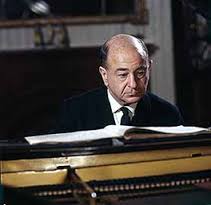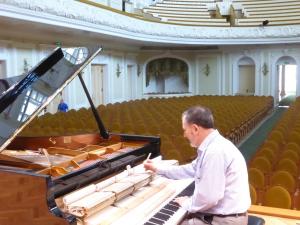 The legendary pianist, Shura Cherkassky made triple ppps (pianississimos) melt in his hands through a fluid keyboard approach that encompassed an array of colors and shadings. In Shura’s exemplary performance of Saint-Saens’ Swan the pianist’s multi-voice tier of dynamics was particularly astounding for its repository of textural timbres. Not surprisingly, the artist’s touch sensitivity intertwined with his uniquely vivid imagination and paired with a well-regulated/voiced piano were important ingredients in his lushly expressive outpourings.
The legendary pianist, Shura Cherkassky made triple ppps (pianississimos) melt in his hands through a fluid keyboard approach that encompassed an array of colors and shadings. In Shura’s exemplary performance of Saint-Saens’ Swan the pianist’s multi-voice tier of dynamics was particularly astounding for its repository of textural timbres. Not surprisingly, the artist’s touch sensitivity intertwined with his uniquely vivid imagination and paired with a well-regulated/voiced piano were important ingredients in his lushly expressive outpourings.
In truth, Cherkassky was known to be ultra concerned with the height of his piano bench and whether it squeaked during his normal shift of body weight at the keyboard, but he also made it a point to check out pianos before a concert for their tone and touch dimensions. In his often perfunctory assessments, he’d breeze over 4 or 5 keys, easily dismissing a whole piano because of one unimpressive register, but for the most part he would not fuss over two nearly matched instruments.
The pianist’s innate sense of “feel” allied to his “sound” ideal had been nursed through years of playing and in one media interview tinged with humor, he confessed that his practicing if overheard, would be akin to the keyboard-wide meanderings of a piano tuner. Perhaps he was NOT fleshing out a percussive approach by analogy, but instead a soft range exploration of peak level responsiveness.
Another fine pianist, Seymour Bernstein, was seen bench hopping from one piano to another in the film Seymour: An Introduction. as he assessed a series of concert grands at Steinway 57th in preparation for his Rotunda performance. (This was prior to the company’s relocation) While Seymour muttered unkind words about one particular model ‘D,’ he swooned over another as Ron Coners senior Steinway technician observed him at a safe distance, arms folded.
While Cherkassky and Bernstein both enjoyed the opportunity to choose a desirable concert-level piano before a recital, Sviatoslav Richter, Russian pianist icon, often journeyed to the countryside playing any piano he was given, making the most of what it offered, even if notes failed to produce sound, or jammed because of long-term neglect.
Ironically, it’s no surprise that to this day many impoverished pianists with significant talent can barely afford a decent piano, though they valiantly march on, playing deficient instruments and making the best of it. (Lucas Debargue, 4th place winner in the XV Tchaikovsky International Competition is an example)
My own humble dilemma in playing a super-well regulated NEW piano beside one that is currently full of bumps and blubbers poses many philosophical and performance-related issues. It’s not that I yearn for a big, booming, tone-defined piano, but I want the opposite–an instrument that responds at the softest dynamic imaginable to a finger sensitive approach.
In the recent XV Tchaikovsky Piano Competition, a very able Steinway trained tuner from Sydney, Australia,(Ara Vartoukian) was dispatched to Moscow to keep the Concert grand Steinway in peak playing condition for a slew of first round contestants that eventually whittled down to six Finalists. His riveting journal entries about the whole competition backdrop are of particular interest in this discussion. They lend credence to the meticulous pursuit of providing a touch/tone satisfactory instrument as a funnel for expressive artistry.
http://www.themeandvariations.com.au/news-events/news/2015/06/piano-expert-on-the-ground-in-russia
Original Content: Tiers of dynamics, well-regulated pianos, and expressive playing

No comments:
Post a Comment